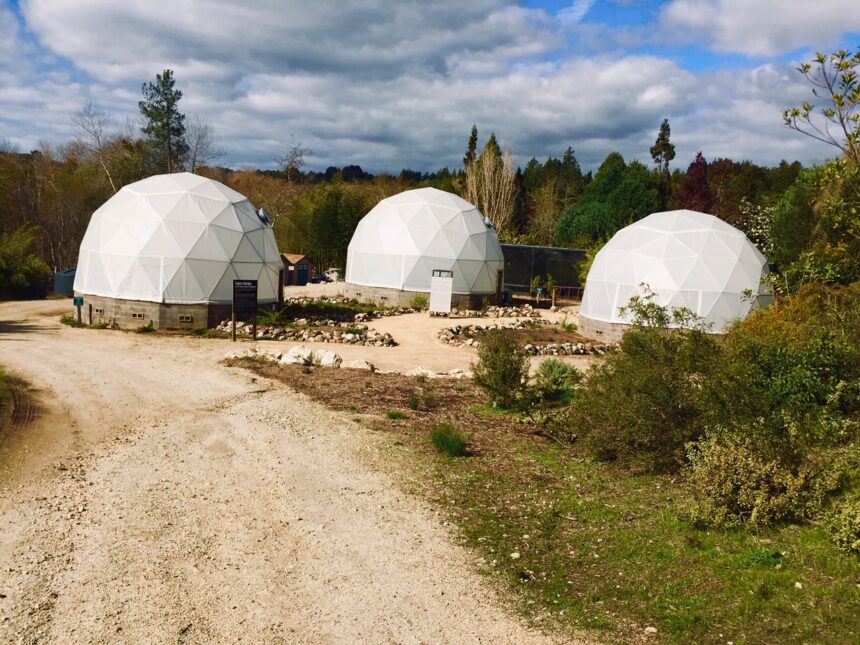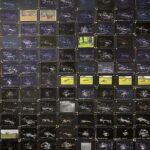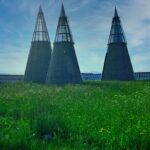Three Ecologies: Conversations with Newton Harrison
Mark Nash
From the work of art to the workings of art.
I would like to start with a quotation from cultural theorist Iain Chambers, a member of The Sticks in the Forest by the Side of the Road, a collective that came about from the idea of artist Jimmie Durham and is one of the group projects invited to Documenta fifteen: “Outside the academic shelter of definitions” writes Iain, “we encounter the slide from product to process, from an isolated aesthetic value to the collective impulse of ethics: that is, from the work of art to the workings of art. In this movement, he continues “through worldly engagement, we are invited to look and listen again to the sensory materialities that simultaneously sustain while cracking the inherited mould of ‘art.’ Digging deeper: this is also a response to other epistemologies, other knowledges, and different constructions and cosmologies, whose specificities oppose an imposed universalism.”
I find this quotation very helpful in characterising what I see as the importance of and Helen and Newton Harrison’s work. They are indeed outside the academic shelter of definitions, all their projects sustain collective impulses and invite us to participate and co-author. If it still makes sense to talk of their work as ‘art’ then their practice and aesthetics is surely about workings of art rather than the art object, the work of art. Simply by being present in the circuit of museums and galleries the sensual materiality of their work helps crack open, fragment the way contemporary art is perceived and experienced if as Chambers says, the mission of contemporary art is to unwind, dissipate and fragment, to destabilise ways of thinking and feeling.
documenta 8
In 1985 Helen and Newton were invited to participate in documenta 8, where they presented a project Kassel Works (documenta 8 1987)– an intervention in city planning. The project involved a series of proposals for making the city more liveable by connecting it to the surrounding landscape, particularly the river. Their proposal involved a bridge over Frankfurter Strasse which separates the town centre from the Aue park and river landscape As they saw it the town had turned its back on the river and they wanted to change that. The Orangerie, where their proposals were being shown, was built in the late 17th early 18th century. It may have been the case that the Hessian aristocracy did not embrace the town planning ideas of a subsequent period. But Newton and Helen were asking different questions – why, following extensive allied bombing, the town was reconstructed along such unsympathetic lines? The answer as Newton tells it was a legacy of Nazi town planning (inherited by the American occupying forces). Why had the stork (a bio indicator of healthy soils) disappeared from the town’s rooftops? And a supplementary question: what was Joseph Beuys doing with oak trees? Newton and Helen are both artists and scientists. Most of their projects have been exhibited in major art museums and galleries. Most involve scientist collaborators or consultants.
What I found fascinating talking with Newton about their documenta project is that on the one hand it didn’t matter that the stuffed stork was a different species from that which used to adorn Kassel’s roof tops. This was after all the artists’ poetic license. They found a convenient solution although the book doesn’t say where they found it. On the other hand, they queried Josef Beuys’ planting oaks in his project 7000 Oaktrees (1982) [1] where 7000 Basalt columns were deposited in front of the Fridericianum with the aim of planting 7000 such trees with accompanying stone markers around the world. Newton objected that a more appropriate species would have been birch! Here the Harrisons were questioning Beuys poetic license. The oak tree was an old German symbol, adopted by both left and right in the 20th century, present both on coinage from the Weimar republic as well as the 1936 Olympics (where contestants were given a live oak tree in a pot to take away). Beuys was being ecologically incorrect in the service of the layers of meaning his work would accrue in referencing Germany history from using the oak tree.
An oscillation between ecological/scientific ‘correctness’ and artistic poetic license is key to much so-called ecological art. What is particular about Newton and Helen is the ‘both/and’- they think and work both as scientists and as artists. The exposition of projects takes the protocols of visual display appropriate to town planning and architecture. The art audience is not always used to applying such focused attention. Before the pandemic I was able to visit with Newton on several occasions and he introduced my Digital Arts and New Media MFA class to the Future Garden in the UCSC arboretum as well as to his studio on Delaware Street, (where it also featured in the opening of the Genomics Institute at UCSC). Future Garden for the Central Coast of California (2020) [2] was a collaboration with the UCSC arboretum and as we speak the plant communities established in the domes are being renewed by UCSC arboretum botanists. Such dialogues with scientists have continued to the present.
Scalability and mitigation
What immediately impressed me with the Force Majeure projects was their focus on scalability and mitigation. Take an example – The Santa Cruz Future Garden project was a small project using three reconditioned Buckminster Fuller geodesic domes, designed to stress different plant species with contrasting heat and drought regimes to force the plant communities to develop adaptations which would be useful for the coming climactic changes. The time span envisaged 50 years – immediately challenging the viewer to imagine a future with different communities of plants. This longue duree approach was immediately appealing to me when I first encountered their work. The other element which was equally appealing and important was that of scalability. Many of the projects, like the gardens or the lagoon cycles can be seen as prototypes for large scale effective mitigation. These Buckminster fuller domes (originally designed to make human shelter more affordable) are here being used both to shelter and stress the plants in their care in order to generate geno- and phenotypes more suited for the climate to come. A nursery for the future.
Ecology/Ecosophy
Paul Virilo said “ecology is the science of the future. We can’t do without it. It will stand as the necessary coherence between the economy in the complex sense of the world and the economy in the ecological sense of the term. I am absolutely convinced and so is Felix Guattari” [3] In his book, as you know, Guattari, borrowed the term ecosophy from Gregory Bateson’s 1972 Steps to an Ecology of Mind. Guattari defines ecosophy as ‘an ethico-political articulation … between the three ecological registers (the environment, social relations and human subjectivity…A new paradigm of ethico-aesthetics could encompass the three registers of a ‘mental, social and environmental ecology’.” [4] Newton has made it clear he’s not so keen on this Bateson/Guattari line of thought. [5] Bateson had visited The Crab Farm project in 1973 as it was being worked on here in UCSD with a Scripps grant but was indifferent. And according to Newton, Guattari’s use of the triad (mental, social and environmental ecology) as an analytic structure is almost as reductive of complexity as that of a binary opposition.
Of course the challenge is that Bateson, influenced by cybernetic kinds of thinking, was working with a concept of mind, whereas Guattari was building on psychoanalytic theory with a very different notion of subjectification. How should we talk today about the production of subjectivity he asked in 1989. He anticipates notions of heterogenous, distributed subjectivities which form the background to our current experience and thinking. Think of the internet and the mobile phone an organ as mentioned yesterday. In the intervening years since Guattari’s essay was written we have realized that these first two terms of his triad: environment and social relations have merged, in the sense that humans have had such effects on the planet that it is difficult to think about environmental ecology without human interference (this is where the concept of the Anthropocene or as others would say Capitalocene comes in).
In preparation for the conference Newton wrote a mail expressing his reservations about the use of Guattari’s concept:
“I am familiar with Bateson’s steps to an ecology of mind and understand why Guattari would claim there are three ecologies. [Actually, Bateson came and visited my crab farm in 1973 as his most effective student, the Freudian anthropologist Robert Levi, was one of my best friends and brought Bateson to see the work. Bateson didn’t like it, looked at it for 30 seconds, walked around the tanks, spoke to no one and left. So, I ended up not liking him either, Bateson or no Bateson.…I am an ecologist. I assert that there is either one ecology or an infinity of microecologies that combine to make this one ecology.” [6]
So, what Bateson does, and what Guatarri does after him, appropriates the word ecology and applies it to things that are not living and therefore not ecological. Now a multitude have appropriated the term. I am not entirely sure what to do. Maybe stop using the term ecology and start using the term web of life.
Newton continued: “There are three webs of life. The social web of life, the mental web of life, and the environmental web of life. Simply doesn’t work. Don’t think you can do it] Don’t know what I am advising you, but have a feeling that if you are going to try to defend Guatarri’s threesome, putting aside Jesus, Mary and Joseph’s threesome, then much later putting aside Freud’s threesome, the ego, the superego and the id. Thereafter, keeping in mind that Guatarri worked many years as a Freudian therapist in mental institutions as a basis for his threesome, in no sense do I argue against Guatari’s foundation insight about the interconnectedness of life and his seeing mycelium as the evidence. However, I assure you, in this context, the rest of the evidence, as each species can also be understood as its own ecology, is virtually endless, since it is manifested in the many many millions of species that live.” [7]
I think Newton may be right in that the concept of mental ecology is not as helpful a concept as I and others would like. Initially I saw it as a way of thinking about psychological resistance to changing human behavior in response to critical social issues such as climate change. But it points us in a much more general direction away from the specificities of art to the production of subjectivity which according to Maurizio Lazzarato represents the primary and perhaps most important work of capitalism? There is a level of abstraction in these formulations which takes us too far from Newton’s work and indeed the work of the work of art, as Iain Chambers formulated it in my opening quotation. Successful art projects such as the Harrison’s manage to change aesthetic and political paradigms or ways of seeing. Newton and Helen Harrison’s work is already opening out possibilities for change. They have already made interventions in mental ecology. And if we prefer to think of this in terms of art so be it.
Curare to care for
As we are regularly reminded these days, the etymology of the word curating comes from the Latin curare to care for. It has taken over from other designations, such as keeper. The keeper of the coins in the British Museum, or indeed of exhibition organizer– these were downgraded or abolished when the cult of curatorial personality meant that all other expressions were no longer relevant. I would like for a moment to dwell on the possibilities of expanding the register of curating as caring, to include hospitality. Looking after objects of course (despite the predations of pillage), but also looking after the visitors– structuring their engagement, caring for these connected functions. And as we repeat in our ritual land acknowledgements concerning the appropriation of first nations land, we should include the notion of curating as looking after the land, or rather respecting those who do. There are different ways this expanded notion of curating can be explored across the Harrisons’ projects.
The artistic direction of documenta fifteen, ruangrupa, have developed a collaborative approach to exhibition making based on the lumbung, the Indonesian term for a rice barn. “Their curatorial approach aims at a collaborative model of resource use— economically, but also in terms of ideas, knowledge, programs, and innovation.” [8] Different contributions are harvested, that is stored both literally and metaphorically in the Fridericianum in the Kassel city center. Harvesting was already a key concept in early works such as the Portable Fish Farm, (Survival Piece 3 1971 Hayward Gallery London) and I am intrigued by the 50-year passage of time which has brought some of these ideas back into focus. The concept of harvesting is key to the upcoming Documenta15 and can easily regarded as caring.
I understand that there will be an exhibition of their work here in San Diego shortly. I wanted to ask some very simple questions about how that exhibition is conceived. If it is not to be a simple chronology from 1969 say to 2023, the curators will have to make choices as to which works to show and how to show them. This “how” of exhibition making is tricky. Sharing the excitement of ecological research and experiment has to also be linked with some kind of narrative— key organising concepts as we have been discussing these last days. The Force Majeure book itself is a form of exhibition. It could hardly be bettered in its deployment of image and text; it already is a catalogue raisonnée. I am impressed by the extensive visual material in the book– lots of photographs and maps. There is a whole cartography of projects which makes me think maybe gather all the maps together in one place. In one sense their work relies on the presentational visual culture of ecological science. One can feel overwhelmed by the amount of information presented. How could we simplify this? One way is the subjective narratives which move each project along the pages. Anecdotal and hubristic, the written text has the affective register of an intimate conversation. In exhibition terms, perhaps this might be translated into speech. Newton is an incisive speaker, and maybe a focus on theatricality might enable viewers/participants to go deeper. The pertinent question here is how to crack open the exhibition to facilitate different forms of knowledge and subjectivity? In other words, how do you plan an exhibition that will open up the world of the Harrisons’ experiments and empower others to work with and learn from their example?
Mark Nash is an independent curator, film historian and filmmaker with a
specialization in contemporary fine art moving image practices, avant-garde and world
cinema. He holds a PhD from Middlesex University and an MA from Cambridge
University. He is currently a professor at the University of California, Santa Cruz, where he founded the Isaac Julien Lab with his partner and long-time collaborator, Isaac Julien.
Notes
[1] https://www.tate.org.uk/art/artworks/beuys-7000-oak-trees-ar00745
[2] https://arboretum.ucsc.edu/visit/garden/other-gardens/future-garden/index.htmlhttps://www.kqed.org/science/1926500/a-glimpse-into-the-future-of-northern-california-plantlife
[3] Paul Virilio ref tc. [Probably in HM and N Harrison the Time of the Force Majeure]London and Munich Prestel Publishing 2016].
[4] Felix Guattari, The Three Ecologies. London: Athlong Press 2000, p. 28.
[5] Newton Harrison email communication 16 February 2022.
[6] Ibid.
[7] Ibid.
[8] https://documenta-fifteen.de/en/about/







